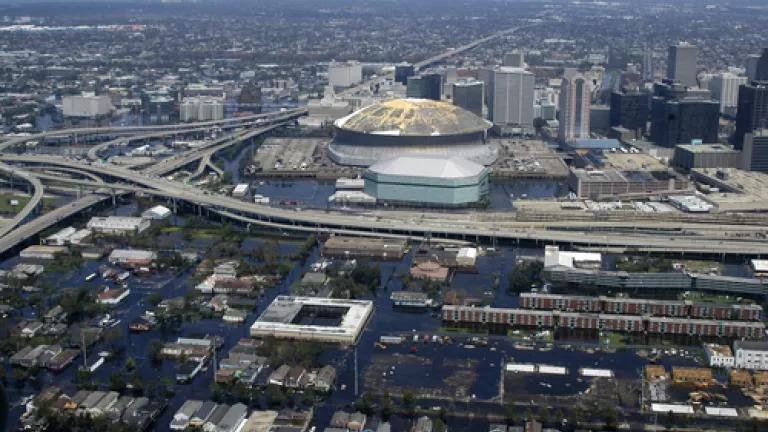
It's hard to believe that ten years have passed since Hurricane Katrina made landfall along the Gulf Coast. I will always vividly remember that week in late August 2005. I was finishing my final semester in college and was taking a course in natural disasters. The scenes of destruction displayed on TV made a particularly strong impression on me as I had lived in New Orleans just a few years prior. News channels showed nearly round-the-clock images of grief-stricken survivors and submerged roads, buildings, and neighborhoods--many located in areas I had regularly explored when I lived there.
Flooding in Central New Orleans on August 31, 2005 (Photo Credit: Jeremy Grisham | US Navy)
As one of the most powerful storms ever to hit the U.S., Katrina left a wake of destruction in her path. The storm killed nearly 2,000 people, rendered more than a million people homeless, left 3 million homes without power, and caused damages of nearly $150 billion. Nearly 80 percent of New Orleans was covered by floodwaters, which ruined almost everything they touched.
Katrina also took a significant toll on the region's drinking water and wastewater systems, which endangered public health. More than 1,200 drinking water systems and more than 200 wastewater treatment facilities in Louisiana, Mississippi, and Alabama were affected by the storm. A preliminary assessment by the American Water Works Association indicated that more than $2 billion in damages to drinking water infrastructure alone were caused by flooding, storm surge, and other impacts. In areas that were not directly flooded, power outages prevented lift stations from pumping, leading to sewage overflowing into homes and roads.
Water infrastructure in New Orleans was particularly devastated by the storm:
- Lack of electricity and flooding of treatment facilities, water distribution lines, and sewer pipes delayed efforts to restore service.
- The city's largest drinking water plant was submerged under floodwaters for almost two weeks.
- The city's largest sewage treatment plant, which served 1.2 million customers, was flooded for a month and did not provide secondary treatment until nearly three months after the storm.
In the ten years since Katrina, we have seen time and time again that critical facilities like drinking water and wastewater systems are highly vulnerable to flooding. During Hurricane Sandy in 2012, critical water facilities in nine East Coast states were either directly damaged or overwhelmed by the storm or lost power, which compromised drinking water safety and led to the release of billions of gallons of untreated sewage. Despite these recurring flood disasters, few improvements have been made to better protect these vulnerable infrastructure systems. Many parts of the U.S., especially coastal areas, face growing flood risks due to sea level rise, more extreme rainfall events, and other climate change threats. Yet, in many cases, we continue to use public funding to build these facilities while blindly ignoring the escalating risks from flooding.
Fortunately, we can learn from past mistakes by improving how we design and build our infrastructure. The State Revolving Funds provide billions of dollars in public funding annually to a variety of water infrastructure projects, and this program can better support projects that protect our drinking water, wastewater, and stormwater systems from flooding and other extreme weather risks. Another significant improvement is to implement federal flood protection standards, which will ensure that taxpayer dollars only fund water and wastewater facilities that are better designed, better sited, and better protected against future flood risks. While we cannot prevent future natural disasters from happening, we can build smarter and safer and diminish the chances that history repeats itself.
